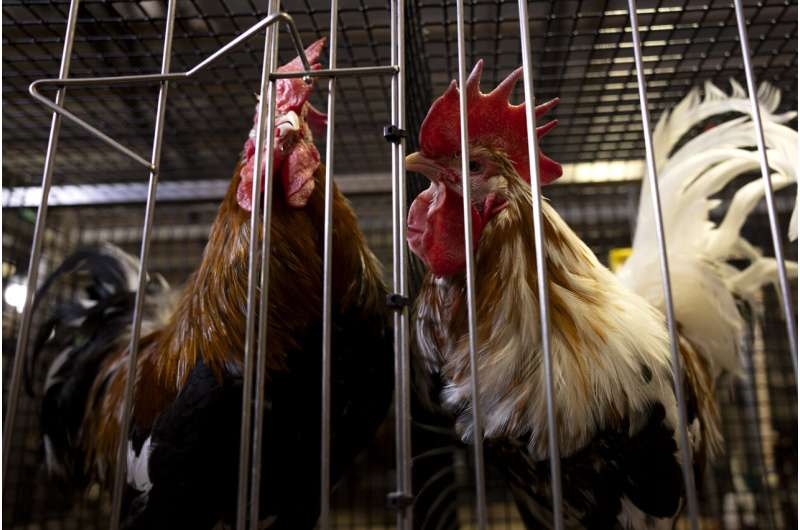This article has been reviewed according to Science X's editorial process and policies. Editors have highlighted the following attributes while ensuring the content's credibility:
fact-checked
peer-reviewed publication
proofread
Unique chicken line advances research on autoimmune disease that affects humans

A unique chicken breed is helping researchers better understand vitiligo, an autoimmune disease that affects 1–2% of the world's population.
In vitiligo, the immune system attacks cells called melanocytes, causing skin pigment to disappear.
The effects are more than skin deep.
"Autoimmune diseases are multifactorial and non-communicable, and one is often associated with other autoimmune disorders. They call it the kaleidoscope of autoimmunity," Gisela Erf, professor of immunology with the Arkansas Agricultural Experiment Station, said. "Vitiligo in humans is strongly associated with autoimmune thyroiditis where the thyroid gland becomes attacked by the immune system, and that's in our vitiligo birds, too."
Why chickens?
Erf studies the disease using a rare vitiligo-prone chicken breed called the Smyth line, the only animal model for vitiligo that shares all the characteristics of the human condition. These include the spontaneous loss of melanocytes, interactions between genetic, environmental, and immunological factors that drive disease expression, and associations with other autoimmune diseases.
Research with the Smyth line helps scientists observe immune responses that are relatable to humans. Erf and her colleagues recently published a study in Frontiers in Immunology titled "Spontaneous immunological activities in the target tissue of vitiligo-prone Smyth and vitiligo-susceptible Brown lines of chicken," which was co-authored by Erf's former graduate students, Daniel M. Falcon and Kristen A. Byrne, and program associate Marites A. Sales.

The study identified the immune mechanisms behind the onset of vitiligo, which could one day inform the development of effective preventative and therapeutic measures for humans.
Erf conducts research through the Arkansas Agricultural Experiment Station as a faculty member of the Center of Excellence for Poultry Science. She holds the Tyson Endowed Professorship in Avian Immunology and teaches classes through the Dale Bumpers College of Agricultural, Food and Life Sciences at the University of Arkansas. The experiment station is the research arm of the University of Arkansas System Division of Agriculture.
Finding answers in feathers
Erf's study compared the immune responses in the Smyth line to its parental Brown line, which is susceptible to vitiligo but much less likely to develop the disease. A unique feature of this animal model is that the melanocyte-containing target tissue—the "pulp" of small growing feathers—is easily accessible. Scientists can sample it many times before and during the onset and progression of the disease without harming the bird, Erf said.
In fact, based on studying the autoimmune response in the feather pulp, Erf developed this tissue as a skin test-site—a "living test tube," she calls it—and a minimally invasive procedure to study immune responses to injected vaccines and other antigens. She has since patented this method.
"The method came out of these vitiligo studies, and it has been an incredibly successful technique, in my opinion, to study these very complex inflammatory responses where the cells get recruited from the blood to the site of infection or injection," Erf said.
Examining growing feathers from the Brown line also revealed immune cells entering the pulp, but these cells exhibited anti-inflammatory immune activities, which may be responsible for preventing vitiligo development in these chickens, Erf explained.
The researchers also detected positive correlations that indicate an immune response involving regulatory T cells, which stop vitiligo development and killing of the melanocytes.
In the Smyth line, approximately one month before vitiligo became visible, an increase in the expression of specific immune regulatory genes was observed. The study states that this early immune activity might play a role in triggering the disease. Overall, their findings align with observations in human studies, with the added benefit of new insights into events before the onset of the disease, Erf added.
This latest study suggests the different responses in Smyth and Brown line chickens could lead to new ways of understanding how the immune system decides between attacking or tolerating melanocytes, Erf said. And that could lead to significant advancements in treatment of autoimmune diseases like vitiligo.
The Smyth chicken was first identified by J. Robert Smyth in 1977 at the University of Massachusetts, Amherst. Erf, who knew Smyth, has worked with the Smyth line since 1989 and maintains the only known research breeding flock in the world.
More information: Daniel M. Falcon et al, Spontaneous immunological activities in the target tissue of vitiligo-prone Smyth and vitiligo-susceptible Brown lines of chicken, Frontiers in Immunology (2024). DOI: 10.3389/fimmu.2024.1386727



















